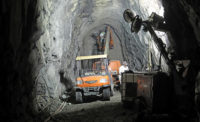ITER Gaining Momentum From New Funding, New Confidence

Achieving 50% construction completion helped ITER win more U.S. funding.
PHOTO COURTESY OF ITER
Funding for research in nuclear fusion was fully restored by Congress in the omnibus spending bill, reversing what supporters feared might be declining interest in the research. An executive of General Atomics said during his March 6 testimony in Congress that he sensed a new attitude toward fusion science.
The bill authorizes $122 million to meet the U.S. 2018 commitment for construction on the $22-billion International Thermonuclear Experimental Reactor project being built by the U.S. and six other international partners in France. San Diego-based General Atomics is building the ITER Central Solenoid, the five-story, 1,000-ton magnet at the center of the facility.
Mickey Wade, director of advanced fusion systems for General Atomics, said in a recent hearing held by a House Science, Space and Technology subcommittee that the chair and co-chair “were very engaged, asking questions about success, rather than about failure.”
Several subcommittee members stayed for 20-25 minutes after the hearing, asking questions of panelists, indicating an interest Wade said he hadn’t seen for years. “I’m hopeful that it means we may have turned some corners in convincing them that fusion is a real activity that the world is really getting behind, and the U.S. needs to be a part of.”
In November 2017, ITER reached 50% completion of the total construction work scope through the first plasma stage, an achievement that Wade credits for helping to boost confidence in Congress.
Fusion can generate electricity without limit or hazardous waste. First plasma is scheduled in 2025 and the first energy for electricity generation in 2035.
The ITER partnership of nations jointly responsible for construction, operation and decommissioning of the facility in St.-Paul-lez-Durance, France, includes China, the European Union, India, Japan, South Korea, the Russian Federation and the U.S.
The U.S. is responsible for about 9% of the project’s construction cost and will be a 13% partner during operations. But the fiscal year 2017 U.S. appropriation was shrunk from $105 million to $50 million, and participants were bracing for another reduction.
Involvement by private enterprise in fusion research is another factor Wade credits for the increase in Congress’ interest in fusion. Research progress advanced by an order of magnitude every 10 years for several decades until 2000 but required the massive investment in ITER to reach the next level, he says.
Research since 2000 has been focused on understanding the physics of the complicated, very high-temperature plasma, but researchers are not waiting for ITER’s first plasma in 2025. “Fusion is too important for just one experiment,” says Martin Greenwald, deputy director of MIT’s Plasma Science and Fusion Center. On March 9, MIT announced a collaboration with a new private company, Commonwealth Fusion Systems, to develop a compact, “high-field” device to contain the initial fusion and the intense heat of the plasma.




